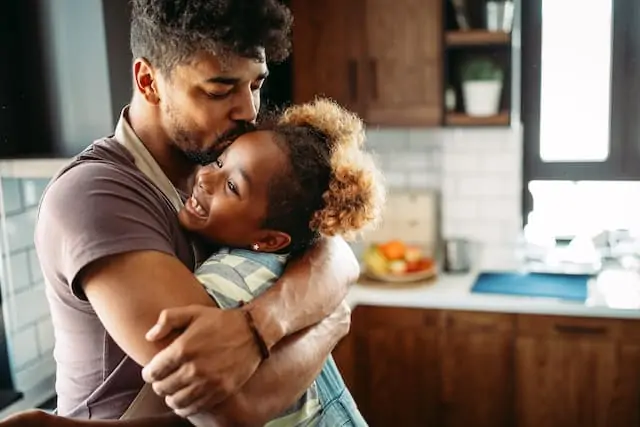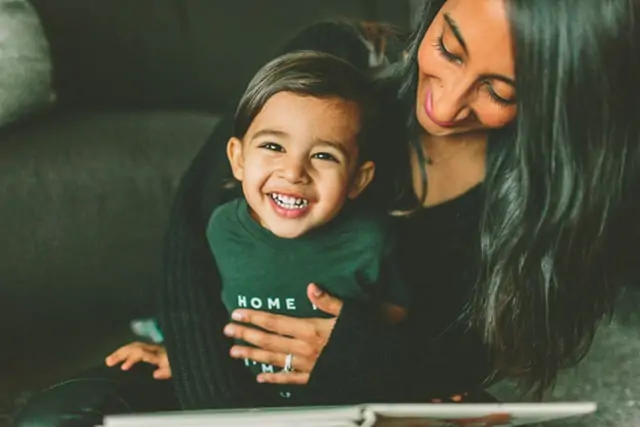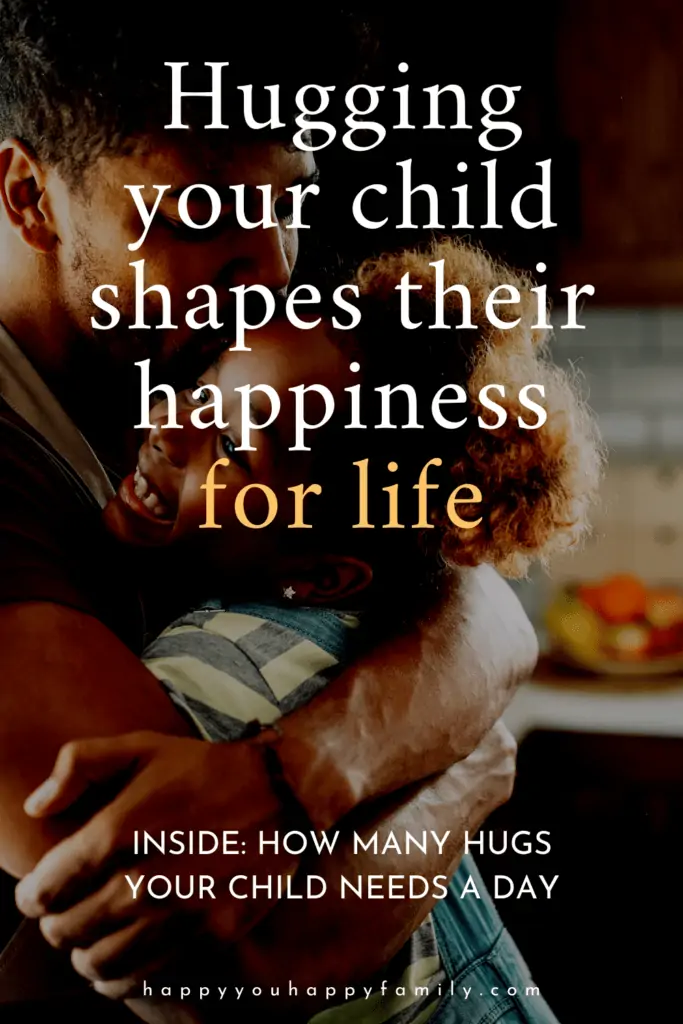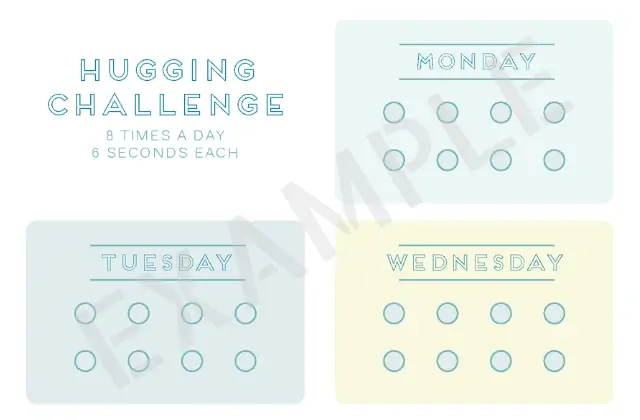How Hugging Your Child Shapes Their Happiness for Life
One morning a while back, my toddler tackled me in a bear hug. As his pudgy arms clung to my neck, I felt my shoulders relax, and my jaw unclenched. The stress of the moment melted away, and I felt fully and deeply connected to my child.
But then I glanced at my oldest, now a teenager, sitting on the couch.
And my stomach twisted with an uncomfortable thought: When was the last time I hugged her like that? I couldn’t remember.
My mind jumped to my other kids, 8 and 6, who were upstairs playing pretend in their room. I racked my brain, trying to think back to our last hugs.
Quick squeezes and pecks on the head, but I couldn’t recall more than that.
Bonus: As a bonus for joining my weekly newsletter, get a free printable that will help you strengthen your hugging habit and make sure your child gets all the powerful benefits that great hugs can provide.
The Importance of Hugging Your Child: 6 Powerful Benefits
As a Certified Parent Educator, I’m trained on the science behind hugs and the benefits of hugging your child.
And yet, I’d gotten so caught up in the go-go-go of daily parenting life that I’d slipped into a bad habit of quick half-second hugs to say good morning or when my kids headed out for the day.
So I went back to review my notes on exactly how a habit of hugging your child for several seconds impacts them. And I uncovered both short-term and long-term benefits:
- A parent’s affection shapes a child’s happiness for life – Several studies have shown that warmth and affection expressed by a parent to their child results in life-long positive outcomes for the child. That includes higher self-esteem, better parent-child communication, and fewer psychological and behavior problems.1Cox, M. J., & Harter, K. S. M. (2003). Parent-child relationships. In M. H. Bornstein, L. Davidson, C. L. M. Keyes, & K. A. Moore (Eds.), Well-being: Positive development across the life course (pp. 191–204). Lawrence Erlbaum Associates Publishers.
- A parent’s affection protects a child – Parental warmth and affection can protect a child from the harmful effects of stress, leading to better mental and physical health outcomes for the child.2Carroll, J. E., Gruenewald, T. L., Taylor, S. E., Janicki-Deverts, D., Matthews, K. A., & Seeman, T. E. (2013). Childhood abuse and biological risk. Proceedings of the National Academy of Sciences, 110(42), 17149-17153.
- A parent’s affection increases a child’s empathy – When a child receives parental warmth and affection, they’re less likely to experience depression and anxiety as an adult, plus they demonstrate a greater capacity for empathy and compassion.3Narvaez, D., Wang, L., & Cheng, Y. (2016). The evolved developmental niche in childhood: Relation to adult psychopathology and morality. Applied Developmental Science, 20(4), 294-309.
- Hugs promote bonding – Warm, affectionate contact like a hug increases oxytocin4Waring B. (2006). A cuddle a day keeps the doctor away. National Institutes of Health Record,58(4), 8-9. , which is a hormone in the body that promotes bonding in a relationship5Dfarhud, D., Malmir, M., & Khanahmadi, M. (2014). Happiness & Health: The Biological Factors – Systematic Review Article. Iranian journal of public health, 43(11), 1468–1477. 6Buchheim, B., Heinrichs, M., George, C., Pokorny, D., Koops, E., Henningsen, P., O’Connor, M., & Gündel, H. (2009). Oxytocin enhances the experience of attachment security. Psychoneuroendocrinology, 34(9), 1417-1422. and facilitates feelings of trust between humans.7Neumann, I. D. (2007). Oxytocin: The Neuropeptide of Love Reveals Some of Its Secrets. Cell Metabolism, 5(4), 231-233. 8Kosfeld, M., Heinrichs, M., Zak, P., Fischbacher, U., & Fehr, E. (2005). Oxytocin increases trust in humans. Nature, 435, 673–676.
- Hugs reduce stress – Scientists have also found evidence that oxytocin can reduce the levels of stress hormones in the body9Waring B. (2006). A cuddle a day keeps the doctor away. National Institutes of Health Record,58(4), 8-9. and promote feelings of relaxation.10Neumann, I. D. (2007). Oxytocin: The Neuropeptide of Love Reveals Some of Its Secrets. Cell Metabolism, 5(4), 231-233. 11Uvnas-Moberg, K., & Petersson, M. (2005). Oxytocin, ein Vermittler von Antistress, Wohlbefinden, sozialer Interaktion, Wachstum und Heilung [Oxytocin, a mediator of anti-stress, well-being, social interaction, growth and healing]. Zeitschrift fur Psychosomatische Medizin und Psychotherapie, 51(1), 57–80.
- Hugs boost your mood – After an increase in oxytocin, the body releases serotonin.12Sohal, V. S. (2013). Serotonin Gives Oxytocin a Helping Hand. Science Translational Medicine, 5(207), 207ec172. You’ve probably heard of serotonin before because it’s known as the “happy chemical” because it boosts your mood.13Mitchell, R. L., & Phillips, L. H. (2007). The psychological, neurochemical and functional neuroanatomical mediators of the effects of positive and negative mood on executive functions. Neuropsychologia, 45(4), 617–629.
To add to all that, I know that if I want nurture a loving parent-child relationship that will last into the teenage years and beyond, the time for nurturing that kind of relationship is now.
So I decided to renew my commitment to hugging my children – truly hugging them, not just quick squeezes.
My go-to solution? The Hugging Challenge.

The Science Behind Hugging Your Child
The Hugging Challenge works because it’s based on the science behind hugs and the science behind behavior change.
Before we get into the specifics of how the Hugging Challenge works, first here’s a quick recap of what research tells us about great hugs:
- How long you hold on matters – When you hold a hug for several seconds, oxytocin14Waring B. (2006). A cuddle a day keeps the doctor away. National Institutes of Health Record,58(4), 8-9. and serotonin15Sohal, V. S. (2013). Serotonin Gives Oxytocin a Helping Hand. Science Translational Medicine, 5(207), 207ec172. start flowing. Those are the chemicals that promote bonding and reduce your stress,16Waring B. (2006). A cuddle a day keeps the doctor away. National Institutes of Health Record,58(4), 8-9. plus they boost your mood.17Mitchell, R. L., & Phillips, L. H. (2007). The psychological, neurochemical and functional neuroanatomical mediators of the effects of positive and negative mood on executive functions. Neuropsychologia, 45(4), 617–629. Science hasn’t given us a definitive answer yet on exactly how long a hug needs to last to get those benefits, but the author of The Happiness Project discovered research indicating that six seconds is where the magic starts to happen.18Rubin, G. (2010). The Happiness Project: Or, Why I Spent a Year Trying to Sing in the Morning, Clean My Closets, Fight Right, Read Aristotle, and Generally Have More Fun. HarperCollins Publishers. In other words, if you want to nurture your bond with your child, a super-short hug won’t cut it. Hold on until you start to feel relaxed.
- How often you hug matters, too – How many hugs do we need a day? Research shows that just one hug a day can improve your mood and decrease conflict in the relationship afterwards.19Murphy M. L. M, Janicki-Deverts D., & Cohen S. (2018.) Receiving a hug is associated with the attenuation of negative mood that occurs on days with interpersonal conflict. PLoS ONE 13(10). e0203522. Researcher and author Dr. Sara Gottfried says that in order to reap the full benefits of the oxytocin that hugs can stimulate, you need to give or receive eight hugs a day.20Carter, C. (2012, May). Happiness Tip: Give 8 Hugs Everyday. Dr. Christine Carter. Eight hugs a day of seven seconds adds up to 56 seconds. That means that in less than a minute a day, you can boost your child’s mood (and yours) plus strengthen your bond.
To add to that, world-renowned psychotherapist Virginia Satir who’s known as the “Mother of Family Therapy”21Virginia Satir. (2002, December 4). In Wikipedia. was famous for saying this:22Comaford, C. (2020, August 22). Are You Getting Enough Hugs?. Forbes.
“We need 4 hugs a day for survival.
We need 8 hugs a day for maintenance.
We need 12 hugs a day for growth.”
Virginia Satir
The Hugging Challenge also builds on the science behind behavior change. For example, below you’ll get a visual cue to serve as a gentle, physical reminder of the goal you set to give your child great hugs. Because when you’re trying to stick to a habit, research shows that a visual cue can remind you of your intention when you’re most likely to forget it.23Patterson, K., Grenny, J., Maxfield, D., McMillan, R., & Switzler, A. (2012). Change Anything: The New Science of Personal Success. Grand Central Publishing.
But here’s the best part: Giving your child several heartfelt hugs a day can be a keystone habit that will nurture your parent-child relationship in a deep way. Keystone habits are special because they kick off a chain reaction, influencing several aspects of your life at once. Translation: You can focus on just one keystone habit, and you’ll experience several positive impacts.24Duhigg, C. (2012). The Power of Habit: Why We Do What We Do in Life and Business. Random House Publishing Group.
Here’s a quick example of how a keystone habit works:
“Take, for instance, studies from the past decade examining the impacts of exercise on daily routines. When people start habitually exercising, even as infrequently as once a week, they start changing other, unrelated patterns in their lives, often unknowingly. Typically, people who exercise start eating better and becoming more productive at work. They smoke less and show more patience with colleagues and family. They use their credit cards less frequently and say they feel less stressed…[For] many people, exercise is a keystone habit that triggers widespread change.”
Charles Duhigg, The Power of Habit†
In my personal experience and in my work with families as a Certified Parent Educator, taking that one simple step of saying “yes” to a healthy hugging habit ends up improving your relationship with your child as a whole.
You’ll feel more connected, and you’ll likely find that you have more patience with your child. And because connection breeds cooperation, your child may start to listen more and be more cooperative.25Markham, L. (2021, May 24). 10 Habits to Strengthen Your Relationship with Your Child. Aha! Parenting.
Related: How to Make Your Child Feel Absolutely Loved: 75 Positive Words for Kids {Printable}
How to Take the Hugging Challenge
Think back to the last couple times you hugged your child. Were they quick squeezes hello or goodbye? Or did you hold on long enough to feel your child relax into you?
To strengthen your hugging habit and make sure your child gets all the powerful benefits that great hugs can provide, try the Hugging Challenge for one week.
This is something I do once in a while to reconnect with the importance of hugging my child, and it works like magic. It’s easy and quick so I can fit it into my busy day, and it gently breaks a “quick squeeze” hug habit, replacing it with a whole-hearted hug habit.
Here’s how the Hugging Challenge works:
- Promise yourself. Set a personal goal to give your child eight great hugs every day for a week.
- Say it. Say your promise out loud or write it down to make the commitment official: “I will hug my child eight times today and every day this week.”
- This is called an implementation intention, and hundreds of studies have shown they help you stick to your goals.26Clear, J. (2018). Atomic Habits: An Easy & Proven Way to Build Good Habits & Break Bad Ones. Avery.
- To get the full benefit of your implementation intention, be as specific as you can. For example, you might list specific times you plan to hug your child, like this: “I will hug my child eight times today and every day this week – once when they wake up, before every meal, anytime we say goodbye, at bedtime, and a couple more spontaneous hugs.”
- Track it. Grab the bonus Hugging Challenge tracker at the end of this post, and use it to keep track of your hugs and mark off one box for every awesome hug you deliver.
- This is a visual cue to help you form the habit.27Patterson, K., Grenny, J., Maxfield, D., McMillan, R., & Switzler, A. (2012). Change Anything: The New Science of Personal Success. Grand Central Publishing.
- Keep your tracker somewhere handy but visible, like in your back pocket, next to your phone, or taped to your steering wheel.
- Hug your child. For every hug, make sure it lasts at least 6 seconds or until you start to feel relaxed.
- If you want to recalibrate yourself during the first few hugs, you can count in your head while you hug your child, but just for fun instead of your typical second-counting phrase like One Mississippi, two Mississippi… or One one thousand, two one thousand, you can try One I love you, two I love you…
- If you want to add a dash of fun and playfulness to your Hugging Challenge and delight your child at the same time, surprise them with a new kind of hug. Find a new hug to try in this list: 21 Sweet and Silly Hugs to Make Your Child Feel Loved.
- Important: While hugging your child is beneficial for you both, the point is not to force hugs on anyone. Just as you probably aren’t always in the mood for a hug, your child sometimes may not want a hug either. You can ask a simple question like “Can I have a hug?” or “Hey, you got a second for a hug?” to remind your child they get to decide. Or as another option, you can use this genius solution to put your child in the driver’s seat on the kind of affection they want.
Related: 101 Heartfelt and Simple Ways to Love Your Child Every Day {Printable}

Get Your Free Printable: The Hug Tracker
Use this free Hugging Challenge tracker to strengthen your hugging habit and make sure your child gets all the powerful benefits that great hugs can provide.
- Get the free printable. Join my weekly-ish newsletter and as a bonus, you’ll get the printable! Just click here to get it and subscribe.
- Print your Hugging Challenge tracker.
- Keep it handy and visible, like in your back pocket, next to your phone, or taped to your steering wheel.
- Hug your child, aiming for eight 6-second hugs a day. On your tracker, mark off one box for every awesome hug you give your child.
Here’s a sneak peek of your printable hug tracker:
Before you go, get my FREE cheat sheet: 75 Positive Phrases Every Child Needs to Hear
Your Turn
What are your thoughts on the importance of hugging your child? Share in a comment below!




Those are some great ideas, and I like the research that you presented.
Glad to hear this resonated with you, Jill! :)
Love these!! Another fun one! The Simon says hug! We started this when my son was about 2 year old.
“Simon says open your arms.”
“Simon says wrap them around your mommy.”
“Simon says squeeeeeeze!”
He loved it! He’s 8 now and whenever he needs an extra smile I just call his name and say, “Simon says open your arms!”
Oh my goodness, Chani. That is the MOST adorable hug tradition! Thank you so much for sharing that. <3
I have definitely fallen into only giving quick hugs. Thank you so much for posting this! I’m looking forward to reconnecting with my kids with some hugs!
Laura, I can certainly relate! Here’s to refreshing our hug habits. :)
We have a “cuddle carry” which my 4yo asks for on a semi regular basis, especially when he’s feeling a bit anxious or reluctant about going somewhere. We started it when I was first dropping him off at childcare. I think it taps into the longer hugging, calming effect. Its basically a standing up cuddle where I pick him up and he wraps his legs round my torso and I start walking – the forward momentum helps us feel pressed closer together.
We also have the “monkey baby” hug where I pretend we’re chimps as he attaches himself with arms and legs round my torso (sometimes front, sometimes side, sometimes back) in a way that I only need one arm to hold him, or sometimes no arms as he’s doing all the ‘holding’. Then I move around in a way that a chimp parent might, slightly swinging him (using my arms to cradle him), which gives a bit of rhythm and movement together.
And this (above) is from a boy who was not a hugger as an infant! Which I found really hard when he was an older baby/toddler as I found it harder to connect with him and felt rejected by his not wanting hugs, or not initiating cuddles.
He still often doesn’t like me kissing him, so I can only sometimes get kisses in as part of a ‘kissy hug’ where I cover him in lots of little kisses in different places and he’ll laugh. I try my best to remember to ask if I can kiss him goodnight before doing so.